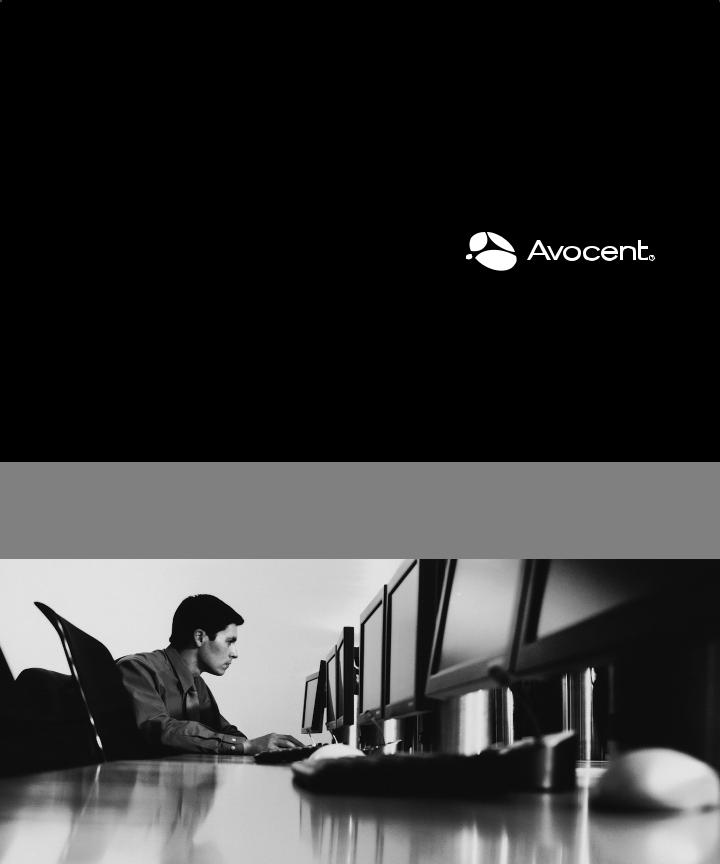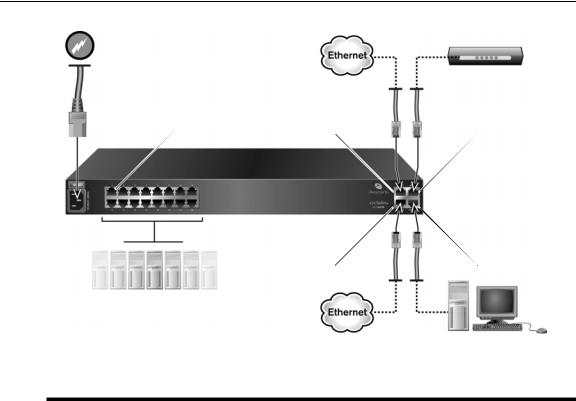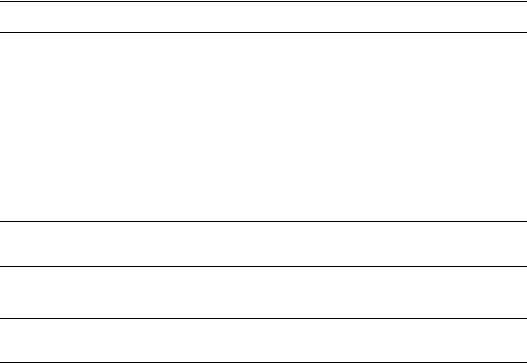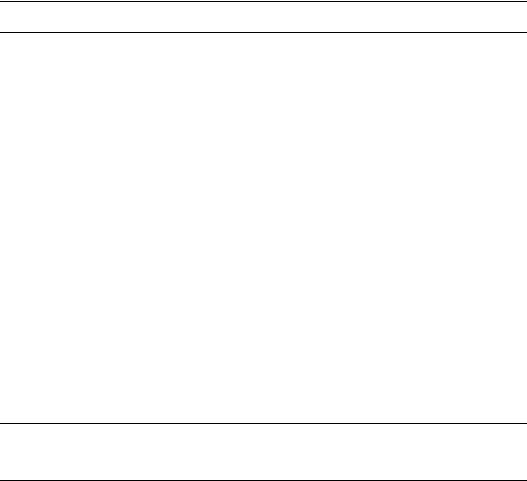Avocent ACS 6000 User Manual

Cyclades® ACS 6000
Command Reference Guide

FCC Warning Statement
The Cyclades ACS advanced console server has been tested and found to comply with the limits for Class A digital devices, pursuant to Part 15 of the FCC rules. These limits are designed to provide reasonable protection against harmful interference when the equipment is operated in a commercial environment.
This equipment generates, uses and can radiate radio frequency energy and, if not installed and used in accordance with the Installation and Service Manual, may cause harmful interference to radio communications.
Operation of this equipment in a residential area is likely to cause harmful interference in which case the user is required to correct the problem at his or her own expense.
Notice about FCC Compliance for All Cyclades ACS Advanced Console Server Models
To comply with FCC standards, the Cyclades ACS advanced console server requires the use of a shielded CAT 5 cable for the Ethernet interface. Notice that this cable is not supplied with either of the products and must be provided by the customer.
Canadian DOC Notice
The Cyclades ACS advanced console server does not exceed the Class A limits for radio noise emissions from digital apparatus set out in the Radio Interference Regulations of the Canadian Department of Communications.
L’Cyclades ACS advanced console server n’émete pas de bruits radioélectriques dépassant les limites applicables aux appareils numériques de la classe A prescrites dans le règlement sur le brouillage radioélectrique edicté par le Ministère des Communications du Canada.
Safety and EMC Approvals and Markings
FCC Class A (USA), CE Class A (EU), ICES-003 (Canada), VCCI (Japan), C-Tick (Australia, no internal modem), A-Tick (Australia, with internal modem), UL 60950-1 (USA), cUL (Canada), EN-60950-1 (EU), CB

Cyclades® ACS 6000
Advanced Console Server
Command Reference Guide
Avocent, the Avocent logo, The Power of Being There, DSView and Cyclades are registered trademarks of Avocent Corporation or its affiliates in the US and other countries. All other marks are the property of their respective owners.
© 2008 Avocent Corporation. 590-770-501B

Instructions
This symbol is intended to alert the user to the presence of important operating and maintenance (servicing) instructions in the literature accompanying the appliance.
Dangerous Voltage
This symbol is intended to alert the user to the presence of uninsulated dangerous voltage within the product’s enclosure that may be of sufficient magnitude to constitute a risk of electric shock to persons.
Power On
This symbol indicates the principal on/off switch is in the on position.
Power Off
This symbol indicates the principal on/off switch is in the off position.
Protective Grounding Terminal
This symbol indicates a terminal which must be connected to earth ground prior to making any other connections to the equipment.

iii
TABLE OF CONTENTS
List of Tables.................................................................................................................. |
vii |
Chapter 1: Introduction, Navigation and Commands ................................................... |
1 |
Access Options and How to Log Into the CLI ................................................................................... |
3 |
Configuration Tasks Performed With the CLI................................................................................... |
3 |
CLI Navigation .................................................................................................................................. |
4 |
Autocompletion .................................................................................................................................. |
5 |
Parameters......................................................................................................................................... |
6 |
Command Line Syntax ....................................................................................................................... |
6 |
CLI Command Set.............................................................................................................................. |
7 |
help ............................................................................................................................................. |
7 |
add .............................................................................................................................................. |
7 |
delete........................................................................................................................................... |
8 |
cd................................................................................................................................................. |
8 |
pwd.............................................................................................................................................. |
9 |
connect........................................................................................................................................ |
9 |
sniff ............................................................................................................................................. |
9 |
share ......................................................................................................................................... |
10 |
disconnect ................................................................................................................................. |
10 |
exit/quit ..................................................................................................................................... |
10 |
ftp .............................................................................................................................................. |
10 |
scp............................................................................................................................................. |
11 |
set.............................................................................................................................................. |
11 |
commit....................................................................................................................................... |
11 |
revert......................................................................................................................................... |
11 |
show/ls ...................................................................................................................................... |
12 |
power_cycle, power_off and power_on.................................................................................... |
12 |
cycle, on, off, lock and unlock................................................................................................... |
12 |
passwd ...................................................................................................................................... |
13 |
opiepasswd................................................................................................................................ |
13 |
Special Multi-session Commands .................................................................................................... |
14 |
listuser ...................................................................................................................................... |
14 |

iv |
Cyclades ACS 6000 Advanced Console Server Command Reference Guide |
|
|
killuser ...................................................................................................................................... |
14 |
|
sendmsg..................................................................................................................................... |
14 |
|
inspectdbuf................................................................................................................................ |
14 |
|
cleandbuf................................................................................................................................... |
15 |
|
wiz............................................................................................................................................. |
15 |
|
CLI Equivalent Actions to Web Manager Checkbox Selection........................................................ |
16 |
|
Chapter 2: Port Access and Configuration Examples................................................ |
19 |
|
View Information About the Console Server and Connected Devices............................................. |
20 |
|
Connect to a Device Console Connected to a Serial Port ............................................................... |
22 |
|
Manage Power for a Device Connected to an Outlet on a PDU..................................................... |
23 |
|
Port Configuration Examples .......................................................................................................... |
23 |
|
Chapter 3: CLI Appliance Settings Options................................................................. |
27 |
|
Appliance_Settings/Global_Settings................................................................................................ |
28 |
|
Appliance_Settings/Network............................................................................................................ |
29 |
|
IPv6........................................................................................................................................... |
32 |
|
Devices...................................................................................................................................... |
32 |
|
Hosts ......................................................................................................................................... |
33 |
|
Wiz command............................................................................................................................ |
34 |
|
Appliance_Settings/Ports................................................................................................................. |
36 |
|
Appliance_Settings/Pluggable Devices ........................................................................................... |
39 |
|
Appliance_Settings/Security ............................................................................................................ |
39 |
|
Appliance_Settings/Authentication.................................................................................................. |
40 |
|
Appliance_Settings/Users ................................................................................................................ |
41 |
|
Appliance_Settings/Syslog ............................................................................................................... |
42 |
|
Appliance_Settings/Event_Notification ........................................................................................... |
42 |
|
Appliance_Settings/Firewall............................................................................................................ |
42 |
|
Appliance_Settings/IPSec(VPN)...................................................................................................... |
43 |
|
Appliance_Settings/SNMP ............................................................................................................... |
44 |
|
Appliance_Settings/Date and Time.................................................................................................. |
45 |
|
Appliance_Settings/Boot Configuration .......................................................................................... |
46 |
|
Appliance_Settings/Online Help...................................................................................................... |
47 |
|
Chapter 4: CLI Overview, Information, Active Sessions and Power Management |
|
|
Options............................................................................................................................ |
49 |

Table of Contents |
v |
Overview Options ............................................................................................................................ |
49 |
Information Options......................................................................................................................... |
50 |
Active Sessions Information............................................................................................................. |
53 |
Power Management Options ........................................................................................................... |
54 |
Appendices..................................................................................................................... |
55 |
Appendix A: Enabling Firmware Upgrades When the Boot Image is not in Flash......................... |
55 |
Appendix B: Technical Support ....................................................................................................... |
56 |
Index................................................................................................................................ |
57 |

vi Cyclades ACS 6000 Advanced Console Server Command Reference Guide

vii
LIST OF TABLES
Table 1.1: ACS 6000 Advanced Console Server Port Descriptions |
.................................................. 2 |
Table 2.1: Port Access and Configuration Tasks ............................................................................ |
19 |
Table 2.2: Topology Parameters ..................................................................................................... |
20 |
Table 3.1: Global Settings Options.................................................................................................. |
28 |
Table 3.2: Network Options............................................................................................................. |
29 |
Table 3.3: Ports Options.................................................................................................................. |
36 |
Table 3.4: Pluggable Devices Options ............................................................................................ |
39 |
Table 3.5: Security Options ............................................................................................................. |
39 |
Table 3.6: Authentication Options................................................................................................... |
40 |
Table 3.7: Users Options ................................................................................................................. |
41 |
Table 3.8: Syslog Options................................................................................................................ |
42 |
Table 3.9: Firewall Options............................................................................................................. |
43 |
Table 3.10: IPSec(VPN) Options..................................................................................................... |
43 |
Table 3.11: SNMP Options.............................................................................................................. |
44 |
Table 3.12: Date and Time Options................................................................................................. |
45 |
Table 3.13: Boot Configuration Options ......................................................................................... |
47 |
Table 4.1: Ports Menu Options........................................................................................................ |
49 |
Table 4.2: Overview Commands...................................................................................................... |
49 |
Table 4.3: Information Options ....................................................................................................... |
51 |
Table 4.4: Active Sessions Field Descriptions................................................................................. |
53 |
Table 4.5: Power Management Options Descriptions..................................................................... |
54 |

viii Cyclades ACS 6000 Advanced Console Server Command Reference Guide

1
CHAPTER
Introduction, Navigation and
1 Commands
The Cyclades ACS 6000 advanced console server is a 1U appliance that serves as a single point for access and administration of connected devices, such as target device consoles, modems and power devices. ACS 6000 console servers support secure remote data center management and out-of-band management of IT assets from any location worldwide.
On ACS 6000 advanced console servers, administration can be performed and connected devices can be accessed with the Command Line Interface (CLI) utility, with the Web Manager or with DSView® 3 management software (version 3.5.1 and greater). Multiple users and administrators can be logged into the console server and connected to ports at the same time.
This manual describes how to access and navigate the CLI utility and how to use it after the console server has been installed and assigned an IP address. For required additional information about actions users can perform, configuration options and tasks that an administrator needs to perform, and for how to install the console server and configure the IP address, see the Cyclades ACS 6000 Installation/Administration/User Guide.
Either the consoles of servers, external modems or Power Distribution Units (PDUs) can be connected to serial ports on the ACS 6000 advanced console server. Supported PDUs include Avocent PM1000/2000/3000s, Cyclades PM IPDUs, Avocent SPC power devices and Server Technology CDUs. Either a PDU or an external modem can be connected to the AUX/Modem port if the port is not factory-configured for an internal modem.
The figure that follows shows the console server ports, and Table 1.1 describes how they are numbered (for use during configuration).

2 Cyclades ACS 6000 Advanced Console Server Command Reference Guide
1 |
4 |
2 |
3 |
5 |
Figure 1.1: ACS 6000 Advanced Console Server Ports
Table 1.1: ACS 6000 Advanced Console Server Port Descriptions
Number |
Description |
|
|
1 |
Serial Port 1 |
|
NOTE: Serial ports are also referred to with tty device names, such as ttSy1, ttyS2 and |
|
so forth. |
|
|
2 |
Eth1 (eth1) |
|
|
3 |
Eth0 (eth0) |
|
|
4 |
AUX/Modem Port (ttyM1 or ttyA1) |
|
NOTE: If an internal modem is ordered and factory installed, this port is configured |
|
internally as a modem port. If an internal modem is not installed, the port is configured as |
|
an auxiliary port, and a PDU or an external modem can be connected to it. The figure |
|
shows an external modem connected. |
|
|
5 |
Console Port |
|
|

Chapter 1: Introduction, Navigation and Commands |
3 |
|
|
Access Options and How to Log Into the CLI
The CLI utility can be accessed in the following ways:
•Through a local terminal or a computer that has a terminal emulation program connected to the console port of the console server with session settings of 9600, 8, N and 1, with no flow control.
•After the console server is connected to the network and has an IP address, it can be accessed by either of the following methods:
•By use of an SSH or Telnet client on a remote computer (if the SSH or Telnet protocol is enabled in the selected Security Profile).
•With the Web Manager - Overview - Appliance Session button.
NOTE: For details on the remote access methods and IP address configuration options, see the Cyclades ACS 6000 Installation/Administration/User Guide.
Administrators have full access to the CLI and to connected devices. An administrator can authorize regular users to access ports, manage power, manage data buffer storage and use one or more console server administration tools. Users can always change their own passwords.
To start the CLI:
1.Access the CLI through the console port, with Telnet or SSH or through the Web Manager.
2.Enter the username and password at the prompt. The cli-> prompt appears.
CLI 2.0 (<build date>)
--:- units cli->
NOTE: The default password for admin is avocent and for root is linux. The password for these users may have been changed during installation of the console server. If not, change the default root and admin passwords to avoid potential security breaches.
Configuration Tasks Performed With the CLI
NOTE: This manual provides some configuration procedures as examples of how to use the CLI; an administrator who wants to use the CLI for configuration should reference the installation/administration/user guide for more information.
The navigation structure of the CLI mirrors that of the Web Manager. Options and parameters are also the same, except that spaces in Web Manager options and parameters are replaced with underscores (_), as in: appliance_settings. Examples that show how to select an option in the Web Manager use a dash surrounded by two spaces ( - ). In the CLI, two similar options in a path are separated by a forward slash (/).

4 Cyclades ACS 6000 Advanced Console Server Command Reference Guide
For example, in the Web Manager, user configuration is done when an administrator selects
Appliance Settings - Users - Local Accounts - User Names to get to the User Names screen. To navigate to the equivalent configuration level in the CLI, an administrator would navigate in the CLI with the cd command followed by the path: cd appliance_settings/users/local_accounts/ user_names.
Administrators should log into the CLI in one window and log into the Web Manager in another window to see how the menu options in the Web Manager map to the navigation options in the CLI. Configuration with the CLI also requires mastery of the following information on CLI navigation and of the CLI commands shown in CLI Command Set on page 7.
CLI Navigation
The CLI navigation options are in a nested tree configuration.
NOTE: When a command line is shown in an example, and the step starts with “Enter,” or when a syntax example is given, the user should type the command as shown and then press Enter. The Enter key is not shown in command line examples unless needed for clarity.
When a user logs in the CLI, the prompt indicates the user is at the /units level.
--:- units cli->
No parameters can be set at this level of the navigation tree.
At any CLI prompt at any level, if you type cd and press Tab Tab, the navigation options (path elements) for that level are listed. Different options appear for administrators and for authorized users.
•When an administrator types the cd command and then presses Tab Tab at the units prompt, the following Units navigation options (path elements) appear.
--:- units cli-> cd<Tab><Tab>
active_sessions/ |
monitoring/ topology/ |
appliance_settings/ overview/ user_profile/
information/ power_management/
•When a regular user types the cd command and then presses Tab Tab at the units prompt, the following Units navigation options appear.
--:- units cli-> cd<Tab><Tab>
overview/ |
power_management/ |
topology/ |
user_profile/ |
Enter cd <one_or_more_path_elements> to move down one or more levels of the navigation tree:
--:- units cli-> cd appliance_settings

Chapter 1: Introduction, Navigation and Commands |
5 |
|
|
A prompt like the following appears at each level:
--:- appliance_settings cli->
NOTE: CLI commands are case sensitive.
At any level, you can press Tab Tab at the prompt to see the commands that can be entered at the current level.
---:- appliance_settings cli-><Tab><Tab> |
|
|||
? |
del |
ls |
quit |
set |
add |
exit |
opiepasswd |
refresh |
shell |
cd |
ftp |
passwd |
revert |
show |
commit |
help |
pwd |
scp |
|
If you know the path, you can enter multiple path elements in a single command separated with forward slashes (/).
--:- units cli-> cd appliance_settings/ports/physical_ports/serial_ports/
--:- serial ports cli->
Enter cd .. to move up one level of the navigation tree. Enter cd ../..[/..] to move up multiple levels.
--:- serial ports cli-> cd ../..
--:- ports cli->
Autocompletion
Autocompletion allows you to type the first few letters of a command or navigation option and then press Tab. The rest of the name is filled in automatically if the letters typed are unique to one command or to a navigation option at that level. If the letters match more than one of the commands or navigation options for that level, the matching options are listed.
For example, if you type cd ov and press Tab at the CLI prompt from the /units level, the overview option will be completed.
--:- units cli-> cd ov<Tab>
--:- units cli-> cd overview
If you then press Enter, you are changed to the overview level, and the overview level prompt appears.
--:- overview cli->
The following example illustrates a case when more than one command matches the letters typed.
--:- units cli-> sh<Tab>
shell show

6 Cyclades ACS 6000 Advanced Console Server Command Reference Guide
Parameters
Some CLI commands take parameters. If you press Tab Tab after a command that requires a parameter, you are prompted to enter the parameter.
Command Line Syntax
NOTE: Square brackets ([ ]) denote an optional element. Each element is separated by a space. There are no spaces between sub-elements.
Command only (help, pwd):
--:- <current_level> cli-> <command>
Commands with paths only (cd, ls, add):
--:- <current_level> cli-> <command> [Path]
Commands with targets (del):
--:- <current_level> cli-> <command> [Path] <Targets>
Commands that require parameters (set):
--:- <current_level> cli-> <command> [Path] <Params>
Commands with values only (sendmsg, ftp...):
--:- <current_level> cli-> <command> [Path] <Values>
where: |
|
Path |
:= path_elem[/path_elem]* |
path_elem |
:= . | .. | Section_Label | ^/ |
Targets |
:= Row_Label(,Row_Label) |
Params |
:= Param_Names=PValues |
Param_Names |
:= Param_Label(:Param_Label)* |
PValues |
:= Value_text(,Value_text)* |
Values |
:= Value_text Value_text |
Section_Label |
|
Param_Label |
|
Value_text |
:= labels or data from the UIC. |
Syntax used: |
|
^ |
: |
beginning of the element |
* |
: |
0 - many |

Chapter 1: Introduction, Navigation and Commands |
7 |
|
|
| : or
() : group
CLI Command Set
NOTE: Most of the commands work from any location when the path to the command parameter is included.
NOTE: The word “node” refers to an entity such as a route, host or user, which can be added, configured or deleted.
help
Generate a help message about how to navigate the CLI.
Syntax:
--:- units cli-> help
- Thank you for using the cli -
This interface allows you to easily modify configurations to customize and define the functionality of your unit.
Press <tab> <tab> to see the list of available commands.
Please refer to the Reference Guide for a description of commands, special keys and additional information on how to use this interface.
Some basic and useful keys are:
up/down arrow - navigates up/down in the command history tab (once/twice) - shows the next possible option(s)
Other hints:
Use backslash '\' to escape spaces, '\' and other control characters when assigning values to parameters.
add
Add a node.

8 Cyclades ACS 6000 Advanced Console Server Command Reference Guide
Syntax:
--:- units cli-> add <Path>
Example:
--:- units cli-> add appliance_settings/network/hosts
--:#- [hosts] cli->
delete
Delete a node.
Syntax:
--:- units cli-> delete <Path> <parameter>
cd
Change directory (level).
Syntax:
--:- units cli-> cd <Path>
Example:
--:- units cli-> cd topology
Displays the following:
--:- topology cli->
Example:
--:- topology cli-> cd .. -or-
--:- topology cli-> cd ../
Moves up one directory level and displays the following:
--:- units cli->
Example:
--:- topology cli-> cd /
Moves to the top level and displays the following:
--:- / cli->
Example:
--:- topology cli-> cd /units/overview
Displays the following:

Chapter 1: Introduction, Navigation and Commands |
9 |
|
|
--:- overview cli->
pwd
Display the path to the current level (print working directory).
Syntax:
--:- units cli-> pwd
connect
Connect to a serial or auxiliary port.
Syntax:
--:- topology cli-> connect <port_name>
Example:
--:- topology cli-> connect 77-77-70-p-2
-or-
(Optional) From the default directory:
--:- units cli-> connect topology/77-77-70-p-2
Displays the following:
Password:
-or-
Type the hotkey to suspend the connection:
Ctrl + z
NOTE: The connect, sniff and share commands allow you to connect to the serial ports. These commands require authentication when single sign-on is disabled, so the password must be entered to authenticate the user in the authentication type configured for the serial port. If single sign-on is enabled or the user has already been authenticated, the session is opened.
sniff
Connect to a serial or auxiliary port as an additional, view-only user.
Syntax:
--:- topology cli-> sniff <port_name>
Example:
--:- topology cli-> sniff 77-77-70-p-2
Displays the following:

10 Cyclades ACS 6000 Advanced Console Server Command Reference Guide
Password:
-or-
Type the hotkey to suspend the connection:
Ctrl + z
share
Connect to a serial or auxiliary port as an additional, read/write user.
Syntax:
--:- topology cli-> share <port_name>
Example:
--:- topology cli-> share 77-77-70-p-2
Displays the following:
Password:
-or-
Type the hotkey to suspend the connection:
Ctrl + z
disconnect
Use this escape sequence to return to the CLI from a connection to a device through a serial port. Syntax:
Ctrl+z
exit/quit
Exit the CLI and return to the login prompt.
Syntax:
--:- units cli-> exit
-or-
--:- units cli-> quit
ftp
Connect to a remote FTP server.
Syntax:
--:- units cli-> ftp [<server_IP_address>|<hostname>]

Chapter 1: Introduction, Navigation and Commands |
11 |
|
|
NOTE: You must log into the CLI as root to have full control over the local directory path. All normal FTP commands apply.
scp
Perform a secure shell copy.
Syntax:
--:- units cli-> scp [[user@]host1:]file1 [...] [[user@]host2:]file2
set
Set a parameter.
Syntax:
--:- units cli-> set <Path> <Parameter>=<Value>
After a parameter has been changed using the set command, a pair of asterisks appear at the beginning of the CLI prompt.
**:- units cli->
Save the change:
**:- units cli-> commit
-or-
Undo the change:
**:- units cli-> revert
NOTE: After a commit or revert command, the asterisks at the beginning of the CLI prompt are replaced by hyphens. Asterisks will not appear after the execution of the set command if using wizard mode, which can be recognized by a prompt that has a pound sign after the colon and the current directory in square brackets (example, --:#- [hosts] cli->).
commit
Save settings.
Syntax:
**:- port_settings cli-> commit
revert
Undo a previous parameter setting.
Syntax:
**:- units cli-> revert
